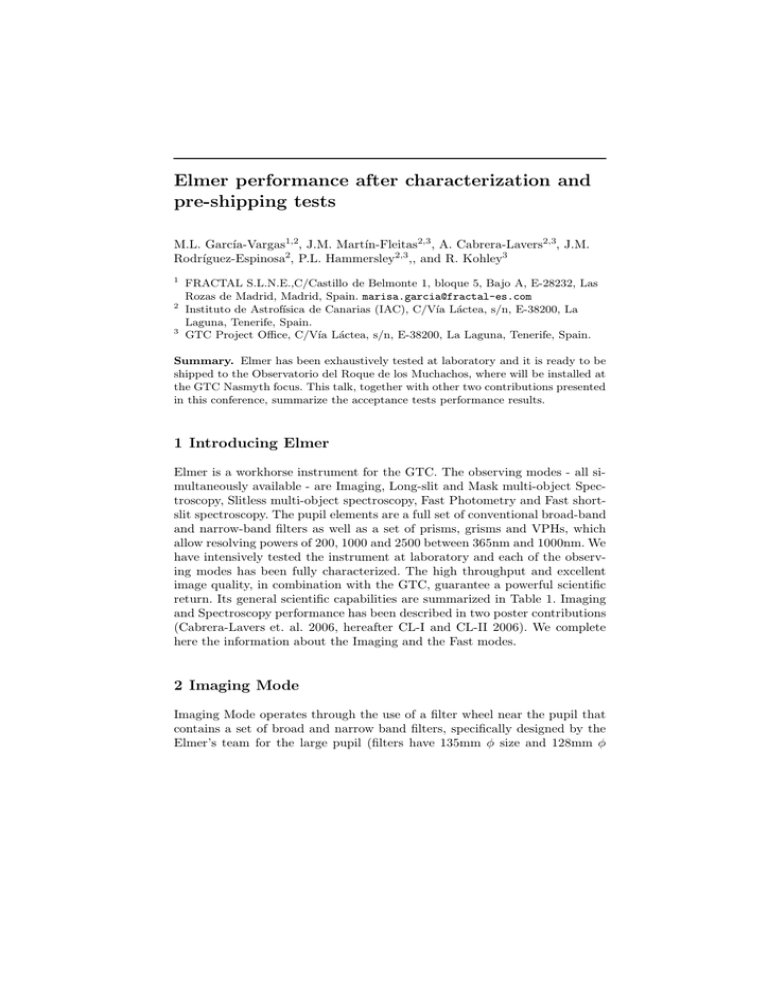Elmer performance after characterization and pre-shipping tests
advertisement

Elmer performance after characterization and pre-shipping tests M.L. Garcı́a-Vargas1,2, J.M. Martı́n-Fleitas2,3, A. Cabrera-Lavers2,3, J.M. Rodrı́guez-Espinosa2, P.L. Hammersley2,3 ,, and R. Kohley3 1 2 3 FRACTAL S.L.N.E.,C/Castillo de Belmonte 1, bloque 5, Bajo A, E-28232, Las Rozas de Madrid, Madrid, Spain. marisa.garcia@fractal-es.com Instituto de Astrofı́sica de Canarias (IAC), C/Vı́a Láctea, s/n, E-38200, La Laguna, Tenerife, Spain. GTC Project Office, C/Vı́a Láctea, s/n, E-38200, La Laguna, Tenerife, Spain. Summary. Elmer has been exhaustively tested at laboratory and it is ready to be shipped to the Observatorio del Roque de los Muchachos, where will be installed at the GTC Nasmyth focus. This talk, together with other two contributions presented in this conference, summarize the acceptance tests performance results. 1 Introducing Elmer Elmer is a workhorse instrument for the GTC. The observing modes - all simultaneously available - are Imaging, Long-slit and Mask multi-object Spectroscopy, Slitless multi-object spectroscopy, Fast Photometry and Fast shortslit spectroscopy. The pupil elements are a full set of conventional broad-band and narrow-band filters as well as a set of prisms, grisms and VPHs, which allow resolving powers of 200, 1000 and 2500 between 365nm and 1000nm. We have intensively tested the instrument at laboratory and each of the observing modes has been fully characterized. The high throughput and excellent image quality, in combination with the GTC, guarantee a powerful scientific return. Its general scientific capabilities are summarized in Table 1. Imaging and Spectroscopy performance has been described in two poster contributions (Cabrera-Lavers et. al. 2006, hereafter CL-I and CL-II 2006). We complete here the information about the Imaging and the Fast modes. 2 Imaging Mode Imaging Mode operates through the use of a filter wheel near the pupil that contains a set of broad and narrow band filters, specifically designed by the Elmer’s team for the large pupil (filters have 135mm φ size and 128mm φ 2 M.L. Garcı́a-Vargas et al. Table 1. Elmer General Capabilities General Capabilities Focal Station Wavelength range FOV Scale at detector Detector Focal Plane Pixel Size Detector capabilities Nasmyth B and Folded-Cassegrain 365 to 1000 nm 4.2’ φ Imaging and Slit-less Spectroscopy 3.0’ x 3.0’ Long Slit and Multi-object Spectroscopy 0.194”/pixel 2048 x 4096 EE2V CCD44-82 15µm x 15µm Charge shuffling and Frame transfer Imaging Modes Broad band Filters Narrow band Filters SDSS set: g’, r’, i’, Z’ [SII]wide 672.6nm, [SII]narrow 671.7nm Hα wide 656.3nm, Hα narrow 656.3nm [OI]630.0nm, [OIII]495.9nm+500.7nm Hβ 486.1nm, [OII]372.7nm Neutral density filters ND2 and ND3 Direct Imaging Over 4.2’ φ FOV Fast Photometry Mode Aperture: 3’ x 12.48” Duty cycle > 98% at 1 Hz Charge Shuffling Yes (at 50µs/line) Spectroscopy Modes Spectral resolution Dispersive elements Long Slit Fast short slit Charge shuffling Mask multi-object Positions for masks R = 50-500 (2 prisms) R = 1000 (2 grisms) R = 2500 (6 VPHs) 2 prisms , 2 grisms and 6 VPHs 3’ x 0.6”, 1.2”, 2.0” and 5.0” 20” x 0.6”, 1.2”, 2.0” and 5.0” 3’ x 0.6”, 1.2”, 2.0” and 5.0” 3’ x 3’ FOV Up to 4 depending on configuration clear aperture) and manufactured by the company OMEGA Optical. The filters have an excellent transmission, see CL-I (2006), and are within the specification tolerances, as shown in the data that have been measured with independent methods by the manufacturer and by us with the use of the VPHs spectral calibration. Filter holders at the wheel are tilted to prevent ghosts due to the main Optics configuration. However, the ghosts associated to the filter’s manufacturing process, based on multi-layer deposition, are specially strong for the narrowest filters and they are unavoidable. During the characterization process we took images through each filter in its optimum focus configuration to measure, on the detector, the position, intensity and orientation of ghosts images with respect to the main image of a pinhole. Figure 1 of CL-I (2006) shows the detected ghosts for the different filters. We strongly Elmer performance after characterization and pre-shipping tests 3 recommend taking into account this effect in the case of high dynamical range images with weak point-like sources. Imaging Mode performance has been reported in CL-I (2006). In summary, over the whole FOV, image quality gives EER80 < 15.0µm, less than 1 pixel; distortion values are smaller than 0.4 % at the corners; plate scale is 0.194”/pix being temperature-independent, and flexure is smaller than 1.3 pix over 180◦ , which can be considered a record for an instrument without any active mechanism for stability compensation. In the following we report some effects that can help to select the adequate observational strategy when using Elmer in Imaging Mode. FOV on detector: Elmer 4.2’ φ FOV is imaged on the CCD upper half (1293 pixels) while the CCD has 2K x 4K pixels. This implies that the CCD’s lower half is not used for Imaging. For this reason the readout mode by default is Frame Transfer, in which the upper half can be exposed while the lower one is being read. Three identical exposures for each image are recommended to be taken, in order to remove the cosmic rays with common reduction routines. Fiducial origin: It is important to know that each filter produces the image of a point-like source in a slightly different position on the CCD. Table 2. Filters Fiducial Positions of the FOV center with respect to r’ Filter g’ r’ I’ z’ Hα broad Hα narrow Hβ [OI] [OII] [OIII] [SII]broad [SII]narrow Focus (mm) X offset(pix) Y offset (pix) 10 12 13 13 12 15 10 11 10 9 17 11 +2.037 +0.000 +3.116 +3.086 +2.038 +4.184 +0.368 +0.091 +1.102 +0.192 +2.498 +0.399 −0.925 +0.000 −0.606 +0.494 −0.749 +1.223 +2.002 +1.476 +0.327 −1.797 +0.166 +0.432 Since the GTC Acquisition and Guiding system will guide with the filter r’, by pointing to the center of the field viewed through that filter, we have chosen the center of the FOV through r’ as the zero pointing reference. Table 2 gives, for each filter, the X and Y offset values (in pixels) for the FOV center, with respect to the center viewed by r’ filter. During the commissioning phase, it should be tested that the center of Elmer’s field is aligned with the telescope optical axis and the table should be corrected accordingly to those results. The observational strategy will be one of the following: (a) the center of the FOV through r’ will be defined as the instrument zero pointing reference and the 4 M.L. Garcı́a-Vargas et al. telescope will correct by making a pointing offset for each filter. In this case all the images on the CCD will be well centered on sky co-ordinates and the same extraction routine will be applied; or (b) the telescope will point the sky object position to the center of the FOV through r’ and then the instrument will take the image. In this case, each image will be taken centered in a slight different sky position and the extraction reduction routine will correct from this effect by taking the offsets on detector from the fiducial position table and extracts a squared image on the detector for each filter, well centered at the real pointing sky co-ordinates. In this later case, if the user does this extraction by himself the effect has to be considered before subtracting images through different filters (e.g. to give colors). To subtract images on real-time then the first observational strategy has to be selected. Narrow Band Imaging: One of the most important specifications for a narrow band filter is the pass band. However, two effects shift the wavelength and affect the transmission performance. These are (a) the temperature change and the incidence angles of the rays at the filter position. Regarding the first effect, the central wavelength of an interference filter shift linearly with changes in ambient temperature (to larger wavelengths for a temperature increase and viceversa). The average value for our set of filters is 0.018 nm/◦ C. The GTC nominal operation temperature ranges between -2◦ C and +19◦ C. The total operation range (the telescope can operate but with degraded performance) is -6◦ C - +35◦ C. Therefore, the maximum wavelength shift will be +0.27nm (at +35◦ C) and -0.47nm (at -6◦ C). We remind the reader that both, image quality and plate scale in Elmer are temperature-independent thanks to Elmer’s athermal optical design. In general, the amount of wavelength shift is dependent upon the incidence angle and the effective index of the filter. The larger the telescope focal plane plate scale is, the larger the shift. In particular, this effect is very strong for instruments at the GTC, with a large plate scale, and fast cameras. Elmer filters are placed near the pupil in the collimated beam. In that position, the effect is unavoidable and the only thing the user can do is to know the instrument performance when using the narrow band filters and take it into account at the time of preparing the scientific observations. Since Elmer filters are in the collimated beam, for each position of the entrance FOV the rays (all parallel) come with a different incidence angle. This produces a wavelength shift that is equivalent to tune the filter (or to transmission variation for a given λ within a given filter). The following formula is used to determine the wavelength shift of a filter in a collimated light (which is the case in Elmer) with incidence angles up to 15◦ . s 2 Ne λ = λ0 1 − sin2 θ (1) Ni where λ is the wavelength at angle of incidence θ, and λ0 is the wavelength at normal incidence, N e is the refractive index of the external medium (1 for Elmer performance after characterization and pre-shipping tests 5 the air) while N i is the filter index. In Elmer, the nominal position for the central FOV is 6◦ tilt to avoid ghosts and the maximum angles between the two extreme positions of the FOV (+2.1’ and -2.1’) are 4.3◦ (corresponding to incidence angles of 1.7◦ for -2.1’ and +10.3◦ for +2.1’ position). Figure 1 shows the shift effect for Hα narrow filter (the worst case). Fig. 1. Hα narrow filter band shift due to the incidence angle. One of the problems is the determination of Ne. We have measured it thanks to the use of the VPHs. We took spectra of a pinhole mask, covering the FOV. We put a given filter plus the appropriate VPH. After spectral calibration, we derived the central λ at each spatial position. From λ and the formula we got Ne. Results are shown in Table 3. Table 3. Measured Central wavelength, band-pass and effective refraction index Filter Hα broad Hα narrow Hβ [OI] [OIII] [SII]broad [SII]narrow λ (Å) 6577 6572 4862 6310 4993 6737 6727 ± ± ± ± ± ± ± ∆ λ (Å) 1 2 2 2 3 3 1 66.3 16.7 25.5 42.4 56.2 69.0 24.2 ± ± ± ± ± ± ± 1.3 0.5 1.2 5.8 1.3 0.6 3.7 Ne 1.72 1.83 2.23 1.86 1.86 1.82 1.71 ± ± ± ± ± ± ± 0.11 0.02 0.15 0.20 0.27 0.17 0.03 Figure 2 illustrates how the shift effect in Hα narrow filter makes that different observed lines through the filter have very different transmission ac- 6 M.L. Garcı́a-Vargas et al. Fig. 2. Transmission at 656.3, 654.8 and 658.4 nm respectively when observing with the Hα narrow filter as a function of the FOV. Lines correspond to Hα and the two [NII] lines at z=0. The line at 658.4 is really out of the pass-band for the whole FOV, but the line at 654.8 becomes important for fields beyond +0.5 arcmin, reaching the same weight than Hα narrow around this value. Hα can be detected with good transmission between -1.5 and +1.0arcmin. These final curves calibrated with the GTC and Elmer) should be taking into account when observing with Elmer. cording to the target spatial position in the FOV. The final flux calibration shall be done during the commissioning at the telescope, by observing a bright planetary nebula, with known and flux-calibrated emission lines, in different positions within the FOV. This will allow producing calibration maps to be used as reference to correct this effect. Also, specifically observational strategies are recommended according to the scientific program’s goals. 3 Fast spectro-photometry capabilities and performance As we have mentioned above, Elmer’s detector has a surface larger than required for imaging the FOV. This allows the implementation of some observing modes like charge shuffling and fast spectro-photometry, which can use the remaining area as charge storage, reaching very high duty cycles. These capabilities open a wide range of scientific possibilities for time-resolving spectrophotometry. In Elmer these modes are simultaneously available with the others since only a movement of the slit wheel is required to accommodate the appropriate mask (Fast Photometry or Fast Slit Spectroscopy apertures) at the telescope focal plane. The sequence for the observation is: (1) Open the shutter (400ms) during CCD clean; (2) Make a loop of exposures and charge Elmer performance after characterization and pre-shipping tests 7 movement (usually to move the sub-image outside the aperture) until CCD is filled with sub-images. This loop is specified by the parameters Nshifts (number of shifts or sub-images) Shiftlen (displacement or number of lines to move each sub-image) and Exptime (exposure time of each sub-image); (3) Close the shutter (400ms) and (4) Readout the CCD. The highest temporal resolution attained is 100µms (with a goal of 50 µms to be tested). In this mode the charge is continuously moved and exposure time is zero (Exptime=0, Nshifts=1, Shiftlen=2700, corresponding to the maximum available number of CCD lines for sub-image storage.). The time between blocks of observation can be couple of seconds depending on the area of the CCD to be read. Fig. 3 shows a real image taken with Elmer fast spectroscopy mode. Fig. 3. Left: Elmer Fast Imaging Mode. Figure shows an image of a central circular aperture’s spectrum, continuously exposed (Ne lamp + VP660- 2500), with 40 subimages of 7 ms of exposure time each, and a displacement of 50 pixels between consecutive sub-images. The smear among images can be seen due to the continuous exposure, and the lines are not continuous because the lamp intensity is changing at a lower frequency (100 Hz) than the line-to-line sampling (10 kHz).Right: Detail at other scale and zoom of the same image showing how the lamp frequency is sampled with exposure and shift times (83 kHz).



